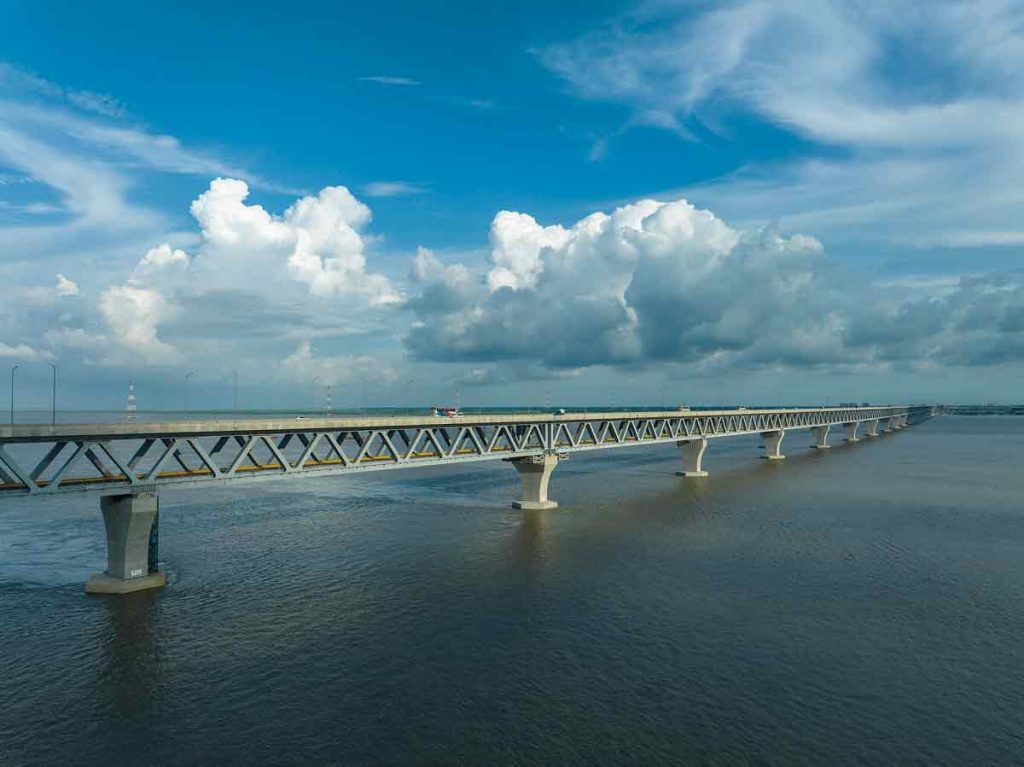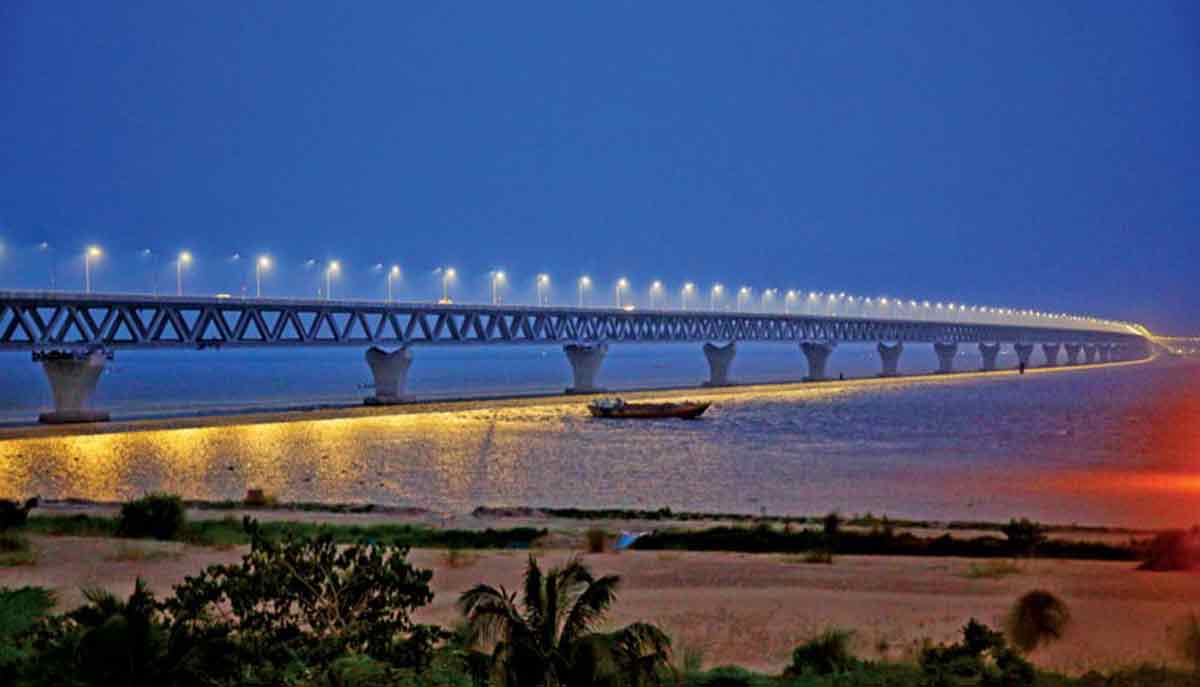A Unique Paragraph on Padma Bridge – Very Informative
Spanning the mighty Padma River in Bangladesh lies a marvel of modern engineering and ambition – the Padma Bridge. Rising majestically from the water, this iconic structure stands as a testament to human ingenuity and perseverance. With its sleek design and strategic location connecting the country’s south-western regions with the capital city of Dhaka, the Padma Bridge is more than just a physical link; it represents progress, unity, and hope for a nation striving towards economic development.
Now read my Paragraph on Padma Bridge to know more indepth about it.
| Name | Padma Bridge |
|---|---|
| Distance (Length) | 3.82 miles (6.15 kilometers) |
| Number of Spans | 41 |
| Height | 390 feet |
| Mile and KM | 3.82 miles (6.15 kilometers) |
| Opened | June 2022 |
| Constructed by | China Major Bridge Engineering Co. Ltd. |
| Construction Started | 26 November 2014 |
| Construction End | 23 June 2022 |
| Designed By | AECOM |
| Earthquake | Designed to withstand earthquakes (Capacity: 9) |
| Connected Area | Southwestern Bangladesh to Dhaka |
| Country of Origin | Bangladesh |
| Design | Dual-level road and rail bridge |
| Website | http://www.padmabridge.gov.bd/ |
| Carries (vehicle) | Motor Vehicles and Railway |
| Named for | Padma River |
| Number of Pillars | 42 |
| River Depth | 122 meters |
| Construction Cost | US$3.6 billion |
Paragraph on The Padma Bridge 100 Words
The Padma Bridge, spanning 6.15 kilometers, opened on June 25, 2022, connecting Louhajong, Munshiganj to Shariatpur and Madaripur, linking 21 districts. Constructed for 30,193.39 crores solely by the Government of Bangladesh, with China Major Bridge Engineering Company Ltd as the builder, it stands as South Asia’s longest bridge. This engineering marvel not only signifies progress but also reduces travel time, enhances market access, and stimulates economic growth. The bridge symbolizes Bangladesh’s determination to overcome challenges and achieve prosperity, embodying a historic leap forward in infrastructure development and regional connectivity.
Padma Bridge Paragraph 150 words
The Padma Bridge, a monumental infrastructure project in Bangladesh, stands as a symbol of progress and connectivity. Spanning the mighty Padma River, it is one of the longest bridges in South Asia, stretching approximately 6.15 kilometers in length. It will connect Louhajong, Munshiganj to Shariatpur, and Madaripur, linking the southwest of the country to northern and eastern regions, thus connecting a total of 21 districts. The bridge comprises a total of 42 pillars, each a testament to the engineering marvel behind its construction.
The project, funded by Bangladesh’s financing for 30 thousand and 193.39 crores, marks a significant milestone in the nation’s development journey. Construction was carried out by China Major Bridge Engineering Company Ltd, employing state-of-the-art engineering techniques and materials to ensure durability and resilience. The Padma Bridge opened on June 25, 2022, marking a historic moment for Bangladesh and symbolizing a leap forward in its infrastructure development.
The completion of the Padma Bridge has brought about numerous benefits, including reduced travel time, improved access to markets and essential services, enhanced regional connectivity, and the stimulation of economic growth and development in Bangladesh’s southwestern region. Beyond its practical significance, the Padma Bridge serves as a testament to Bangladesh’s ambition and determination to overcome challenges and achieve greater prosperity for its people.
Padma Bridge Paragraph 300 Words
In a groundbreaking feat of engineering ingenuity, Bangladesh proudly unveiled its newest icon of connectivity in June 2022: the Padma Bridge. Spanning a staggering 3.82 miles (6.15 kilometers) over the mighty Padma River, this architectural marvel stands as a testament to human innovation and determination.
The genesis of the Padma Bridge project was not without its challenges. Tasked with navigating the treacherous terrain of monsoons and seismic activities, Dr. Robin Sham and his team from Hong Kong embarked on a journey marked by innovation and resilience. Their vision crystallized into a design that defied convention, boasting prefabricated steel truss modules and seismic-resilient structures capable of withstanding the harshest of natural forces.
One of the most striking features of the Padma Bridge is its dual-level design, accommodating both road and rail traffic. Beneath the bustling lanes of commuters lies a freight railway, seamlessly linking Bangladesh to the Trans-Asian Railway Route and opening up new avenues for trade and commerce.
The completion of the Padma Bridge signals more than just a triumph of engineering; it heralds a new era of economic prosperity and social cohesion. Gone are the days of arduous ferry crossings and interminable travel times. With the bridge’s inauguration, the southwestern region of Bangladesh finds itself seamlessly connected to the bustling metropolis of Dhaka, paving the way for enhanced trade, tourism, and economic development.
But perhaps the most profound impact of the Padma Bridge lies in its ability to bridge not just physical distances, but also socioeconomic divides. By facilitating faster and safer travel, the bridge promises to unlock new opportunities for the communities it serves, propelling Bangladesh into a future defined by progress and possibility.
As the sun sets on the horizon, casting its golden glow upon the Padma Bridge, one cannot help but marvel at the indomitable spirit of human endeavor. In this towering testament to innovation and collaboration, Bangladesh finds itself poised on the precipice of a brighter tomorrow, united by the bonds of steel and the promise of a better future.

The Padma Bridge – A Long Paragraph
The Padma Bridge, a colossal engineering feat situated in Bangladesh, stands as a testament to human ingenuity, perseverance, and the nation’s unwavering commitment to progress. Spanning the mighty Padma River, this monumental infrastructure project is not merely a structure of steel and concrete but a symbol of hope, connectivity, and transformation. With a length stretching approximately 6.15 kilometers, it ranks among the longest bridges in South Asia, embodying the spirit of innovation and ambition that defines the modern era of infrastructure development.
The inception of the Padma Bridge dates back to the early 2000s when Bangladesh identified the urgent need for enhanced connectivity between its capital city, Dhaka, and the southwestern region of the country. The Padma River, one of the major rivers of Bangladesh, posed a formidable barrier to transportation and economic development, particularly during the monsoon season when ferry services were disrupted. Recognizing the socio-economic benefits of bridging this divide, the government embarked on an ambitious journey to construct a bridge that would unite disparate regions, stimulate trade and commerce, and improve the overall quality of life for millions of Bangladeshis.
The planning and design phase of the Padma Bridge project involved meticulous deliberation, consultation with experts, and rigorous feasibility studies. Engineers and architects collaborated to develop a structure that could withstand the challenges posed by the Padma River’s dynamic hydrology, including high water flow, sedimentation, and riverbank erosion. The chosen design, featuring a long-span cable-stayed bridge with multiple spans supported by towering pillars, showcased a harmonious blend of functionality, aesthetics, and structural integrity.
Construction of the Padma Bridge commenced in earnest in 2007, marking the beginning of a decade-long endeavor marked by both triumphs and tribulations. The scale and complexity of the project presented numerous challenges, from securing adequate funding to navigating environmental regulations and addressing logistical constraints. However, with unwavering determination and the support of international partners, including multilateral development banks and engineering firms, Bangladesh pressed forward, overcoming obstacles with resilience and fortitude.
One of the defining aspects of the Padma Bridge project was its reliance on domestic resources and expertise, underscoring Bangladesh’s commitment to self-reliance and capacity-building. While international assistance played a crucial role in providing technical know-how and financial support, the bulk of the construction work was executed by local contractors and laborers, harnessing the nation’s human capital and empowering communities across the project’s corridor.
As construction progressed, the Padma Bridge began to take shape, its towering pillars rising majestically from the riverbed, and its intricate cable-stayed structure spanning the vast expanse of the Padma River. Each phase of construction brought new milestones and challenges, from the installation of massive precast segments to the delicate process of tensioning the bridge cables to achieve optimal structural integrity. Throughout it all, safety remained paramount, with stringent measures in place to protect workers and ensure adherence to international construction standards.
The completion of the Padma Bridge on June 25, 2022, marked a historic moment for Bangladesh, signaling the dawn of a new era of connectivity and progress. The bridge’s opening ceremony was attended by dignitaries from around the world, who hailed it as a symbol of Bangladesh’s emergence as a regional powerhouse and a beacon of hope for other developing nations grappling with similar infrastructure challenges. With its sleek design, state-of-the-art technology, and sheer magnitude, the Padma Bridge captured the imagination of millions, inspiring awe and admiration for the ingenuity of its creators.
Beyond its aesthetic appeal, the Padma Bridge holds immense practical significance for Bangladesh and its people. By reducing travel time between Dhaka and the southwestern region, the bridge has facilitated greater mobility and access to essential services, including healthcare, education, and markets. This has not only improved the quality of life for millions of Bangladeshis but also spurred economic growth and development in previously marginalized areas, unleashing the region’s untapped potential and creating new opportunities for prosperity.
Moreover, the Padma Bridge serves as a catalyst for regional integration, connecting the southwestern region of Bangladesh with the northern and eastern parts of the country, as well as neighboring countries such as India and Nepal. This has opened up new avenues for trade, investment, and collaboration, fostering cross-border cooperation and strengthening ties between nations.
In addition to its economic and social benefits, the Padma Bridge is a source of national pride and identity for Bangladesh, symbolizing the nation’s resilience, ambition, and unity in the face of adversity. It stands as a monument to the collective efforts of countless individuals – engineers, laborers, government officials, and citizens – who came together to realize a shared vision of progress and prosperity.
Looking ahead, the Padma Bridge represents not merely an end but a new beginning for Bangladesh, as the nation embarks on a journey of sustainable development and inclusive growth. As its people traverse the bridge’s span, they carry with them the hopes and aspirations of generations past and future, forging a path towards a brighter, more interconnected future for all. The Padma Bridge is more than just a bridge; it is a symbol of possibility, resilience, and the transformative power of human endeavor.
Padma Bridge Toll List
| Vehicle Type | Toll (in BDT) |
|---|---|
| Motorcycles | 100 BDT |
| Cars | 750 BDT |
| Pickup/Mircobus/Minibuses | 1200/1300/1400 BDT |
| Buses | 2400 BDT |
| Small/ Medium/ Heavy Trucks | 1600/2100/2800 BDT |
| Heavy Vehicles ( Truck 3 Axle) | 5500 BDT |
Word Meaning For Kids
| Word | Meaning |
|---|---|
| Spanning | Extending across or over something |
| Engineering | The branch of science and technology |
| Marvel | Something that causes wonder or astonishment |
| Stimulates | Encourages or promotes activity |
| Prosperity | Success, wealth, and well-being |
| Connectivity | The quality or state of being connected |
| Infrastructure | The basic physical and organizational structures |
| Embodies | Represents or exemplifies |
| Leap | A significant or abrupt change |
| Overcome | Succeed in dealing with a problem or difficulty |
| District | An administrative division of a country |
| Symbolizes | Represents or stands for something |
| Access | The means or opportunity to approach or enter |
| Reduction | The act of making something smaller or less |
| Solely | Only, exclusively |
Benefits of The Padma Bridge
The Padma Bridge, a monumental infrastructure project, stands as a symbol of progress and development for Bangladesh. Spanning the mighty Padma River, this bridge holds immense promise, not only in terms of connectivity but also in transforming the economic landscape of the nation. Let’s delve into the myriad benefits it brings to Bangladesh, particularly in terms of economic impact and business progress.
- Enhanced Connectivity
- The Padma Bridge connects the southwest region of Bangladesh, including districts like Khulna and Jessore, with the capital city, Dhaka, and other major economic hubs. This enhanced connectivity reduces travel time and costs, facilitating the movement of goods, services, and people.
- Improved accessibility stimulates economic activity in previously isolated regions, unlocking their potential for development and investment.
- Boost to Trade and Commerce
- The bridge acts as a vital link in the Trans-Asian Railway network and the Asian Highway network, facilitating regional trade and connectivity. It opens up new avenues for trade with neighboring countries like India, Nepal, and Bhutan.
- Reduced transportation costs and improved logistics efficiency contribute to the competitiveness of Bangladeshi goods in domestic and international markets, fostering trade growth.
- Accelerated Industrialization
- The proximity to major industrial zones and export processing zones along the bridge’s corridor encourages industrial growth and investment. Industries can now access a larger pool of skilled labor and raw materials, leading to increased production and exports.
- Improved transportation infrastructure attracts foreign direct investment (FDI) in sectors such as manufacturing, textiles, and agribusiness, driving industrialization and job creation.
- Tourism and Hospitality
- The scenic beauty surrounding the Padma Bridge corridor offers immense potential for tourism development. Tourist attractions, cultural sites, and eco-tourism destinations in previously inaccessible areas become more accessible, attracting domestic and international tourists.
- The hospitality sector experiences a boom with the influx of tourists, leading to the development of hotels, restaurants, and recreational facilities along the bridge route, generating employment opportunities and economic growth.
- Agricultural Development
- The bridge facilitates the transportation of agricultural produce from rural areas to urban markets, reducing post-harvest losses and improving farmers’ access to markets and agricultural inputs.
- Enhanced connectivity encourages agricultural diversification and value addition, promoting the growth of agribusinesses and agro-processing industries in the region.
Conclusion
After reading paragraph on Padma Bridge, you can easily know that this stands as a testament to Bangladesh’s commitment to progress and development. Its completion heralds a new era of economic growth, connectivity, and prosperity for the nation.







